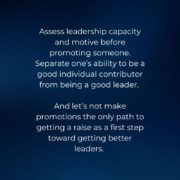10 Keys For Leading In The Layoffs
If your business is at all connected to the oil patch, layoffs have become so common this year that it is unusual to meet a senior manager who hasn’t had to manage a reduction in their work force or isn’t in the midst of planning one. It is helpful to reflect on ways to provide leadership in times of downsizing and uncertainty
The decision to downsize and the choice of who is to be laid off can be so wrenching that many managers have little energy left to consider what happens after the layoff. How do you help the shell-shocked survivors recover and move forward in a productive way? How can you rebuild a great culture after you have laid people off? How can you build morale and increase employee engagement when you are downsizing your workforce?
Below are ten strategies for guiding your culture toward cohesiveness, engagement, and trust while laying people off. Even if your organization isn’t currently cutting back its workforce, you will find these approaches helpful in the midst of any change:
1) Acknowledge the emotions. During layoffs, people go through a wide range of legitimate feelings and they need structured opportunities – half an hour a week or the first ten minutes of a meeting – to express honestly how they are doing. Just because people didn’t get laid off doesn’t mean they’re happy.
2) Make it safe to open up. As a leader, you aren’t responsible to fix the feelings that arise; people have to take responsibility to deal with their own emotions. Your job is to create a respectful and safe space where people can open up and feel support from the organization. Let people know that being honest will never be a career limiting decision. If you find people are holding back in these sessions, get them into smaller groups where you know there are pockets of trust.
3) Allow some space for grieving. People need space to grieve and say good-bye to their colleagues and friends. I’ve seen people cry and hug as they walk out the door. You cannot make it worse by inviting people to be honest. It’s about being human, and supporting this helps create a more fully human organization. How can we expect people to be engaged if we don’t accept and support people to be where they are?
4) Exercise patience – with yourself and others. Recognize that when people are in shock they behave in uncharacteristic ways. When people are vulnerable they may act out or blow their top. Don’t be surprised if it happens to you. As managers, you’ve been busy planning and managing the layoff and solving problems. Cut yourself some slack and don’t forget to apologize personally to anyone who got in the path of your outburst. Emotional turmoil is all part of the transition process. It is a positive step forward and everyone needs to learn to deal with emotions constructively in a way that doesn’t inflict pain or fear.
5) Respect that people are in a transition. One day everything is fine; the next day a layoff is announced. One day you have a department with a hundred people; the next day there are sixty-five. These are external changes that can happen quickly. Transition, the reorientation that people go through to come to terms with the change, takes time and intentional leadership. Give people time and clarity to understand the process of transition and the time to work through it.
6) Focus on creativity and community, not productivity. While it’s unrealistic to expect that work is going to stop while people come to terms with their emotions, putting added pressure on them when they are hurting and stressed by the workload creates mistrust, destructive tension, increased anxiety, and low morale. There’s always a drop in productivity. Smart leaders understand this and work with it. Getting the group to help you solve problems and come up with creative solutions is a good way to get support yourself, get collective wisdom from your team, and give people a sense of meaningful importance.
7) Create an opportunity for people to have some degree of control. Destructive stress is created when people feel they don’t have any influence over what is happening. There are two fundamental questions that need to be answered in tumultuous times:
- What are we committed to preserve? Not all change is good. We have to be clear and have some control over what we won’t allow to change.
- What must we be willing to let go of? People need to be given the opportunity to acknowledge and say good-bye before they can start to think about the future.
8) Share as much information as you can. Tell people what you know. Tell them what you don’t know. Information eases stress.
9) Bring a compass with you. It is a habit of human beings to run faster when we have lost our way. In these chaotic, uncertain, demanding times, we just don’t know what we will face ahead of us, and there is no road map to take us there. It’s more important than ever to stop and get your bearings. Be guided by a vision, values, and principles, both personally and organizationally, rather than by emotions or the pressures of others.
10) Build a Bridge and Get Over It. Eventually, even with all the support and strategies for being creative and building a collaborative community in your organization, you have to get on with your work and your life. You have to take accountability for your own emotions and reactions, and make a decision to change your attitude, support your organization, or move on.
For those who have experience with layoffs and downsizing, you know that, while the current reality may be chaotic, one can always take solace in the fact that the sun will rise tomorrow to allow you to get on with the next chapter of your life. Look forward to the adventure with some focused planning, a firm resolve, a renewed vision for the future, patience, perseverance, and a positive outlook.
If your organization is currently undergoing significant change, feel free to contact me to explore how I might help guide you through the transition process.









